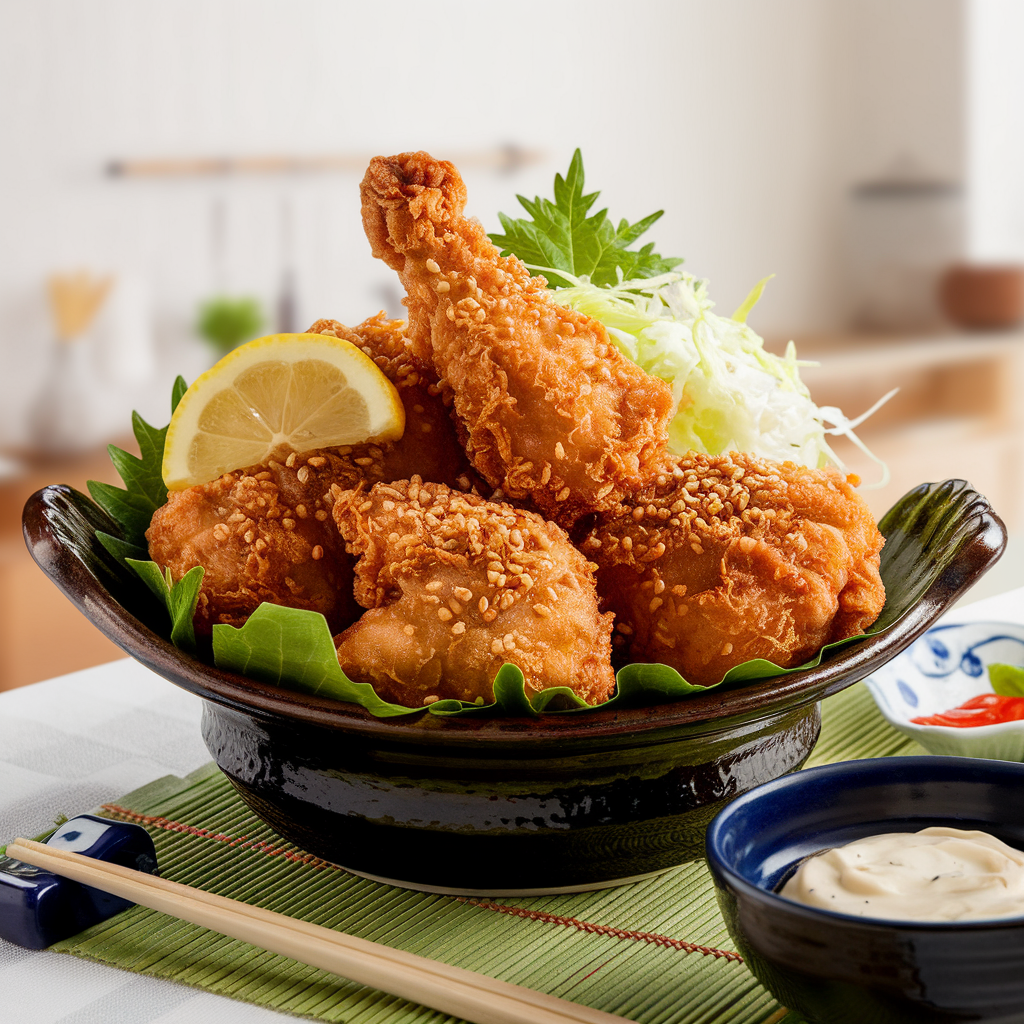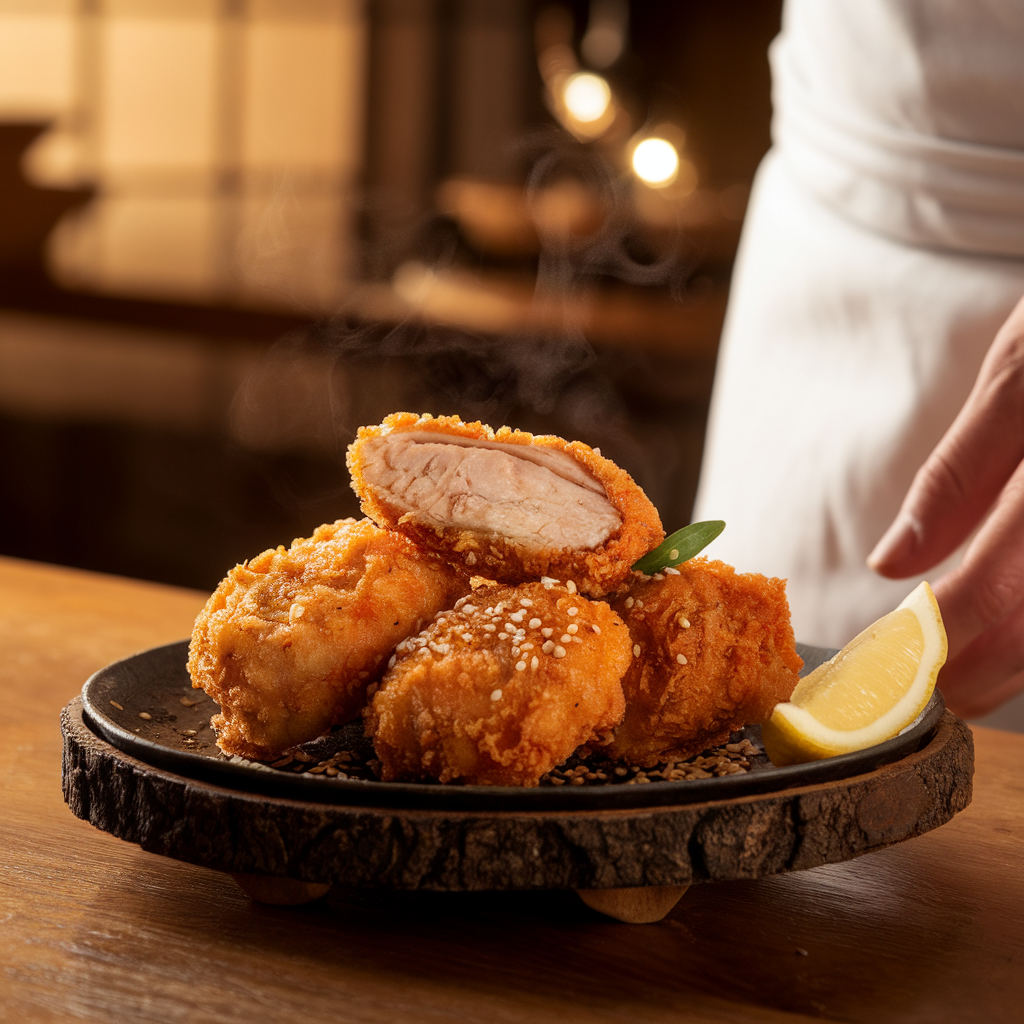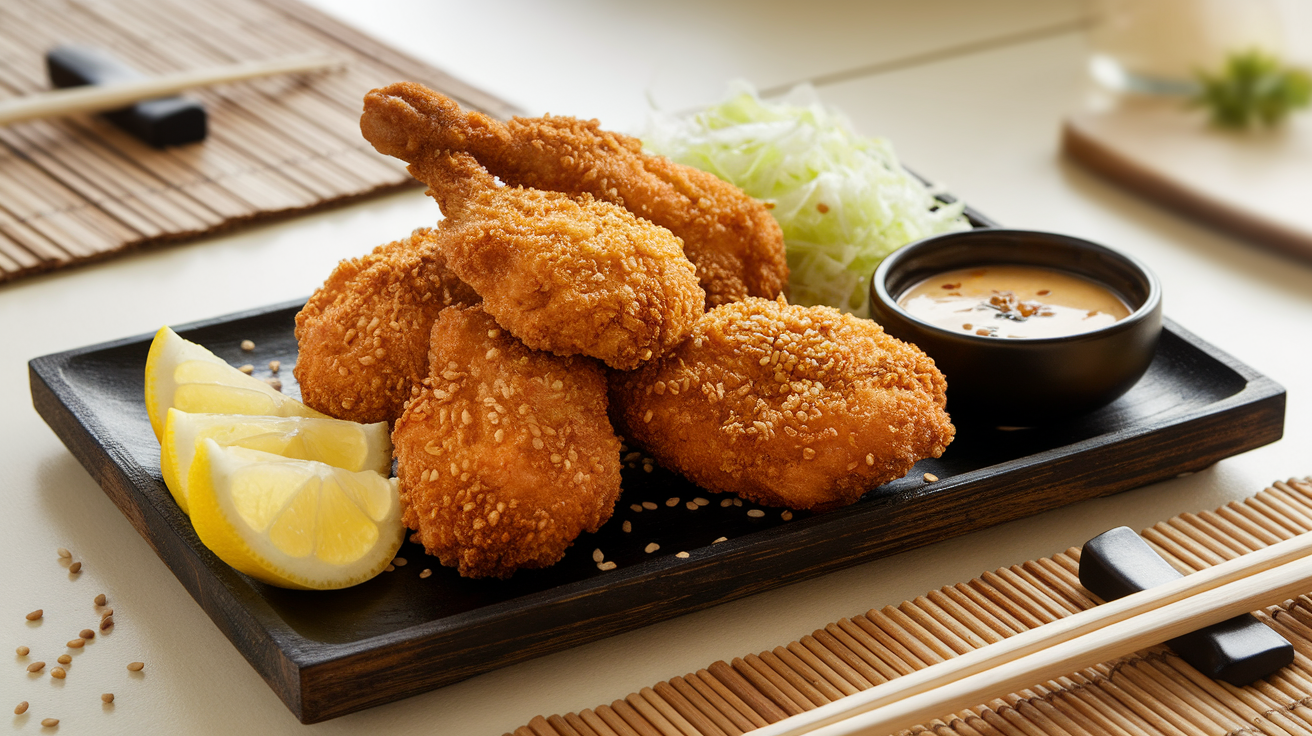Crispy, juicy, and packed with umami flavor, this Chicken Karaage recipe brings authentic Japanese fried chicken straight to your kitchen.
Introduction to Chicken Karaage
If you’ve ever dined in a Japanese izakaya or sampled Asian fried chicken, chances are you’ve encountered Chicken Karaage, Japan’s beloved take on fried chicken. Unlike the thick-battered American version, Karaage (pronounced kara-ah-geh) is made by marinating bite-sized chicken in soy sauce, sake, garlic, and ginger, then coating it in potato starch and double-frying it to golden perfection.
Karaage is irresistibly crisp on the outside and incredibly juicy inside. Often served with a wedge of lemon and a side of Japanese mayo or ponzu sauce, it’s a dish that’s equally perfect for a quick dinner, lunch bento box, or crowd-pleasing appetizer.
In this guide, we’ll explore the origins of Chicken Karaage, its key ingredients, a step-by-step recipe, cooking tips, dipping sauce ideas, serving suggestions, and cultural significance in Japan.
Origins of Karaage – A Japanese Street Food Icon
The term “karaage” (唐握げ) refers to a Japanese cooking technique where food—usually chicken—is marinated, then lightly coated and fried. Originating in the 1920s, Karaage grew in popularity due to its flavorful marinade and light, crispy coating that doesn’t overpower the meat.
Karaage is now deeply rooted in Japanese home cooking and can be found in everything from high-end restaurants to 7-Eleven bento boxes. With global love for Asian fried chicken, Karaage has carved out its niche next to Korean and Taiwanese fried chicken variants.
More than a recipe, Karaage is a cultural experience. Families prepare it for school events, sports days, festivals, and picnics. The aroma alone evokes nostalgia for many in Japan.
Why You’ll Love This Chicken Karaage Recipe
- ✅ Crispy on the Outside, Juicy Inside
- ✅ Authentic Flavors from soy sauce, sake, garlic, and ginger
- ✅ No Deep Fryer Needed – A stovetop skillet works perfectly
- ✅ Kid-Friendly and Perfect for Meal Prep
- ✅ Pairs Well With Dipping Sauces, Rice, or Slaws

Ingredients for Chicken Karaage
Para el Pollo:
- 500g boneless chicken thighs, skin-on preferred
- 2 cucharadas de salsa de soja
- 1 tablespoon sake (or dry white wine)
- 1 tablespoon mirin
- 1 diente de ajo, grated
- 1 teaspoon grated ginger
- ½ teaspoon sesame oil (optional but authentic)
For Coating and Frying:
- ½ cup potato starch (or cornstarch)
- Vegetable oil, for frying
For Serving:
- Gajos de limón
- Japanese mayo or dipping sauce (more ideas below)
- Thinly sliced cabbage or shredded lettuce (optional garnish)
Paso a Paso las Instrucciones
🥣 1. Marinate the Chicken
Cut the chicken thighs into bite-sized pieces (around 1½ inches). In a mixing bowl, combine soy sauce, sake, mirin, garlic, ginger, and sesame oil. Add the chicken pieces and massage the marinade into them. Cover and refrigerate for 30 minutes to 2 hours.
🧠 Pro Tip: The longer it marinates (up to 12 hours), the more flavorful your karaage will be.
🍥 2. Coat in Potato Starch
Remove the chicken from the marinade and pat dry slightly. Dredge each piece in potato starch—this creates a thin, crisp shell that shatters when bitten.
🍘 Potato starch is key for that authentic Japanese crunch. Cornstarch is a decent backup but yields a slightly different texture.
🍳 3. Heat the Oil
In a heavy-bottomed pan or deep skillet, heat about 1½ inches of vegetable oil to 170°C (340°F). Use a thermometer if possible for accuracy.
🔥 4. Fry the Chicken (Double Fry Method)
Fry the chicken in batches, being careful not to overcrowd. Cook each batch for 90 seconds to 2 minutes, until the exterior starts turning golden. Remove and drain on a wire rack or paper towels.
Once all chicken is fried, increase oil temperature to 190°C (375°F) and re-fry each batch for another 30–45 seconds. This second fry ensures extra crunch and seals in juiciness.
🍋 5. Serve and Enjoy
Serve immediately with lemon wedges, dipping sauces (see below), and shredded cabbage or steamed rice.

Chicken Karaage Dipping Sauce Ideas
Pair your karaage with a variety of sauces to enhance flavor and add richness:
- 🧄 Japanese Mayo + Sriracha: Creamy with a spicy kick
- 🍋 Ponzu Sauce: Tangy citrus soy sauce
- 🥢 Yuzu Kosho: A fermented Japanese chili paste
- 🧂 Togarashi Salt: Spicy Japanese 7-spice blend
- 🍜 Kewpie Mayo + Soy Sauce: Creamy, umami-rich
Cooking Tips for Perfect Chicken Karaage
💡 Use Chicken Thighs – The fat content helps keep the meat juicy and flavorful during frying.
💡 Dry Before Frying – Gently pat the marinated chicken with paper towels before dredging in starch.
💡 Don’t Skip the Double Fry – This method crisps up the coating and prevents sogginess.
💡 Batch Frying – Overcrowding the pan drops the oil temp, making the chicken oily instead of crispy.
💡 Serve Fresh – Karaage tastes best when hot and crispy. If reheating, use an air fryer or oven, not the microwave.
Variations & Substitutions
🍗 Karaage with Mochiko Flour
Try using Mochiko (glutinous rice flour) instead of potato starch for a “mochi fried chicken” feel. It gives a slightly chewier bite and is a fun fusion twist.
🐓 Air-Fried Karaage
For a healthier version, cook in the air fryer at 200°C (390°F) for 12–14 minutes, flipping halfway through.
🎷 Karaage Bento
Pack leftover karaage in a lunchbox with rice, pickles, and boiled egg for a true Japanese bento experience.
What to Serve with Chicken Karaage
Looking for the perfect meal pairing? Here are some great ideas:
- 🍚 Steamed White Rice or Sushi Rice
- 🥬 Shredded Cabbage Salad with Sesame Dressing
- 🍢 Miso Soup
- 🥤 Japanese Pickled Radish (Takuan)
- 🍶 Chilled Sake or Iced Green Tea

Storage and Reheating Tips
- ❄️ To Store: Keep karaage in an airtight container in the fridge for up to 3 days.
- 🔥 To Reheat: Air fryer at 180°C for 5–6 minutes, or reheat in a 200°C oven for 10 minutes.
- ❌ Avoid microwaving: It ruins the crispy coating.
Karaage also freezes well. Flash-freeze on a tray, then store in zip-lock bags for quick future meals.
Nutritional Information (Per Serving)
| Nutrient | Amount |
|---|---|
| Calories | ~290 kcal |
| La proteína | 23g |
| Fat | 18g |
| Carbohydrates | 9g |
| Sodium | 500mg |
Values are approximate and vary depending on oil absorption and ingredients used.
Why Chicken Karaage is the Ultimate Crowd-Pleaser
Whether you’re hosting a party, prepping for the week, or just craving something savory and crunchy, Chicken Karaage ticks all the boxes. It’s flavorful, portable, and endlessly adaptable.
Unlike typical fried chicken recipes, karaage is known for its bold, fragrant marinade and ultra-thin, extra crispy shell—making it one of the most addictive dishes in Japanese cuisine.
Its global popularity is growing thanks to Japanese pop culture, food bloggers, and travelers who fall in love with its satisfying flavor profile. From food trucks in Los Angeles to ramen bars in London, karaage is earning its well-deserved spotlight.
Reflexiones Finales
Chicken Karaage isn’t just another fried chicken recipe—it’s a gateway to Japan’s culinary soul. Its umami-rich marinade, perfectly crisp exterior, and juicy interior create a crave-worthy dish that leaves everyone reaching for seconds.
So whether you’re already a fan of Japanese chicken nuggets, interested in trying mochi fried chicken, or just want an easy savory recipe that delivers every time, this Japanese Karaage recipe is a must-try.


